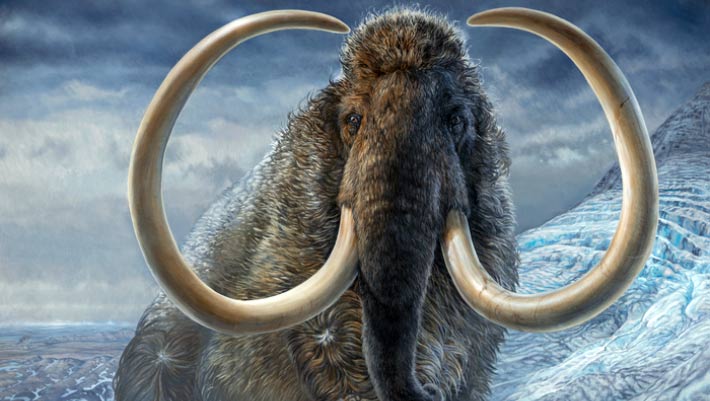
Scientists have examined isotopes collected from the tusk of a woolly mammoth (Mammuthus primigenius) that lived in Alaska approximately 17,100 years ago, during the latest Ice Age, to elucidate its movements and diet; this included its time — likely with a herd — as an infant and juvenile, then as a prime-age adult, and then as a declining senior over its approximately 28-year life span.
An illustration of an adult male woolly mammoth (Mammuthus primigenius) navigates a mountain pass in Arctic Alaska, 17,100 years ago. Image credit: James Havens / University of Alaska Museum of the North.
Despite being one of the most widely studied and iconic Ice-Age creatures, very little is known about the natural life history of woolly mammoths.
Thus, their home range and mobility — where and how far these large creatures roamed throughout their lives — remain largely a mystery.
However, since regular migrations across great distances characterize the mobility patterns of their living elephant relatives and other Arctic animals, it is assumed that woolly mammoths exhibited similar behaviors.
“Discovering more about the lives of extinct species satisfies more than curiosity,” said Professor Matthew Wooller, a researcher at the University of Alaska Fairbanks.
“Those details could be surprisingly relevant today as many species adapt their movement patterns and ranges with the shifting climate.”
In the study, Professor Wooller and his colleagues examined a 1.7-m-long tusk of a woolly mammoth.
They pieced together the animal’s journey by analyzing isotopic signatures in the tusk from strontium (Sr) and oxygen, which were matched with maps predicting isotope variations across Alaska.
They created the maps by analyzing the teeth of hundreds of small rodents from across Alaska held in museum collections. The rodents travel relatively small distances during their lifetimes and represent local isotope signals.
Using that local dataset, they mapped isotope variation across Alaska, providing a baseline to trace the mammoth movements.
“Strontium isotope ratios (87Sr/86Sr) in soils and plants reflect the underlying bedrock geology, which vary across landscapes,” they explained.
“As animals eat these plants, 87Sr/86Sr patterns from the region become incorporated into tissues.”
“Thus, the 87Sr/86Sr ratios contained in tissues that continually grow throughout life, like mammoth tusks, for example, can provide a record that can be used to trace an animal’s movement over time.”
After taking geographic barriers into account and the average distance it traveled each week, the researchers used a novel spatial modeling approach to chart the likely routes the animal took during its life.
Ancient DNA preserved in the mammoth’s remains allowed the team to identify it as a male that was related to the last group of its species that lived in mainland Alaska.
“Those details provided more insight into the animal’s life and behavior,” said Professor Beth Shapiro, a researcher at the University of California, Santa Cruz.
“For example, an abrupt shift in its isotopic signature, ecology and movement at about age 15 probably coincided with the mammoth being kicked out of its herd, mirroring a pattern seen in some modern-day male elephants.”
“It’s not clear-cut if it was a seasonal migrator, but it covered some serious ground,” Professor Wooller said.
“It visited many parts of Alaska at some point during its lifetime, which is pretty amazing when you think about how big that area is.”
“Knowing that he was male provided a better biological context in which we could interpret the isotopic data,” Professor Shapiro added.
“Isotopes also offered a clue about what led to the animal’s demise. Nitrogen isotopes spiked during the final winter of its life, a signal that can be a hallmark of starvation in mammals.”
“It’s just amazing what we were able to see and do with these data,” said Dr. Clement Bataille, a researcher at the University of Ottawa.
“The Arctic is seeing a lot of changes now, and we can use the past to see how the future may play out for species today and in the future,” Professor Wooller concluded.
“Trying to solve this detective story is an example of how our planet and ecosystems react in the face of environmental change.”
The study is published in the journal Science.
_____
Matthew J. Wooller et al. 2021. Lifetime mobility of an Arctic woolly mammoth. Science 373 (6556): 806-808; doi: 10.1126/science.abg1134
 #Bizwhiznetwork.com Innovation ΛI |Technology News
#Bizwhiznetwork.com Innovation ΛI |Technology News



